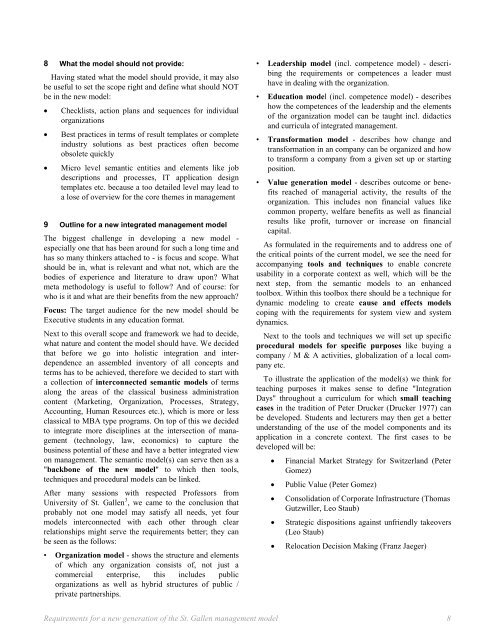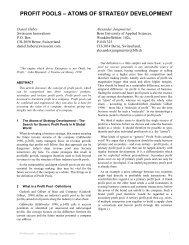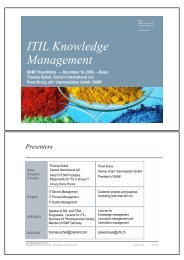requirements for a new generation of the st. gallen management ...
requirements for a new generation of the st. gallen management ...
requirements for a new generation of the st. gallen management ...
You also want an ePaper? Increase the reach of your titles
YUMPU automatically turns print PDFs into web optimized ePapers that Google loves.
8 What <<strong>st</strong>rong>the</<strong>st</strong>rong> model should not provide:<br />
Having <strong>st</strong>ated what <<strong>st</strong>rong>the</<strong>st</strong>rong> model should provide, it may also<br />
be useful to set <<strong>st</strong>rong>the</<strong>st</strong>rong> scope right and define what should NOT<br />
be in <<strong>st</strong>rong>the</<strong>st</strong>rong> <<strong>st</strong>rong>new</<strong>st</strong>rong> model:<br />
• Checkli<strong>st</strong>s, action plans and sequences <<strong>st</strong>rong>for</<strong>st</strong>rong> individual<br />
organizations<br />
• Be<strong>st</strong> practices in terms <<strong>st</strong>rong>of</<strong>st</strong>rong> result templates or complete<br />
indu<strong>st</strong>ry solutions as be<strong>st</strong> practices <<strong>st</strong>rong>of</<strong>st</strong>rong>ten become<br />
obsolete quickly<br />
• Micro level semantic entities and elements like job<br />
descriptions and processes, IT application design<br />
templates etc. because a too detailed level may lead to<br />
a lose <<strong>st</strong>rong>of</<strong>st</strong>rong> overview <<strong>st</strong>rong>for</<strong>st</strong>rong> <<strong>st</strong>rong>the</<strong>st</strong>rong> core <<strong>st</strong>rong>the</<strong>st</strong>rong>mes in <strong>management</strong><br />
9 Outline <<strong>st</strong>rong>for</<strong>st</strong>rong> a <<strong>st</strong>rong>new</<strong>st</strong>rong> integrated <strong>management</strong> model<br />
The bigge<strong>st</strong> challenge in developing a <<strong>st</strong>rong>new</<strong>st</strong>rong> model -<br />
especially one that has been around <<strong>st</strong>rong>for</<strong>st</strong>rong> such a long time and<br />
has so many thinkers attached to - is focus and scope. What<br />
should be in, what is relevant and what not, which are <<strong>st</strong>rong>the</<strong>st</strong>rong><br />
bodies <<strong>st</strong>rong>of</<strong>st</strong>rong> experience and literature to draw upon? What<br />
meta methodology is useful to follow? And <<strong>st</strong>rong>of</<strong>st</strong>rong> course: <<strong>st</strong>rong>for</<strong>st</strong>rong><br />
who is it and what are <<strong>st</strong>rong>the</<strong>st</strong>rong>ir benefits from <<strong>st</strong>rong>the</<strong>st</strong>rong> <<strong>st</strong>rong>new</<strong>st</strong>rong> approach?<br />
Focus: The target audience <<strong>st</strong>rong>for</<strong>st</strong>rong> <<strong>st</strong>rong>the</<strong>st</strong>rong> <<strong>st</strong>rong>new</<strong>st</strong>rong> model should be<br />
Executive <strong>st</strong>udents in any education <<strong>st</strong>rong>for</<strong>st</strong>rong>mat.<br />
Next to this overall scope and framework we had to decide,<br />
what nature and content <<strong>st</strong>rong>the</<strong>st</strong>rong> model should have. We decided<br />
that be<<strong>st</strong>rong>for</<strong>st</strong>rong>e we go into holi<strong>st</strong>ic integration and interdependence<br />
an assembled inventory <<strong>st</strong>rong>of</<strong>st</strong>rong> all concepts and<br />
terms has to be achieved, <<strong>st</strong>rong>the</<strong>st</strong>rong>re<<strong>st</strong>rong>for</<strong>st</strong>rong>e we decided to <strong>st</strong>art with<br />
a collection <<strong>st</strong>rong>of</<strong>st</strong>rong> interconnected semantic models <<strong>st</strong>rong>of</<strong>st</strong>rong> terms<br />
along <<strong>st</strong>rong>the</<strong>st</strong>rong> areas <<strong>st</strong>rong>of</<strong>st</strong>rong> <<strong>st</strong>rong>the</<strong>st</strong>rong> classical business admini<strong>st</strong>ration<br />
content (Marketing, Organization, Processes, Strategy,<br />
Accounting, Human Resources etc.), which is more or less<br />
classical to MBA type programs. On top <<strong>st</strong>rong>of</<strong>st</strong>rong> this we decided<br />
to integrate more disciplines at <<strong>st</strong>rong>the</<strong>st</strong>rong> intersection <<strong>st</strong>rong>of</<strong>st</strong>rong> <strong>management</strong><br />
(technology, law, economics) to capture <<strong>st</strong>rong>the</<strong>st</strong>rong><br />
business potential <<strong>st</strong>rong>of</<strong>st</strong>rong> <<strong>st</strong>rong>the</<strong>st</strong>rong>se and have a better integrated view<br />
on <strong>management</strong>. The semantic model(s) can serve <<strong>st</strong>rong>the</<strong>st</strong>rong>n as a<br />
"backbone <<strong>st</strong>rong>of</<strong>st</strong>rong> <<strong>st</strong>rong>the</<strong>st</strong>rong> <<strong>st</strong>rong>new</<strong>st</strong>rong> model" to which <<strong>st</strong>rong>the</<strong>st</strong>rong>n tools,<br />
techniques and procedural models can be linked.<br />
After many sessions with respected Pr<<strong>st</strong>rong>of</<strong>st</strong>rong>essors from<br />
University <<strong>st</strong>rong>of</<strong>st</strong>rong> St. Gallen 3<br />
, we came to <<strong>st</strong>rong>the</<strong>st</strong>rong> conclusion that<br />
probably not one model may satisfy all needs, yet four<br />
models interconnected with each o<<strong>st</strong>rong>the</<strong>st</strong>rong>r through clear<br />
relationships might serve <<strong>st</strong>rong>the</<strong>st</strong>rong> <<strong>st</strong>rong>requirements</<strong>st</strong>rong> better; <<strong>st</strong>rong>the</<strong>st</strong>rong>y can<br />
be seen as <<strong>st</strong>rong>the</<strong>st</strong>rong> follows:<br />
• Organization model - shows <<strong>st</strong>rong>the</<strong>st</strong>rong> <strong>st</strong>ructure and elements<br />
<<strong>st</strong>rong>of</<strong>st</strong>rong> which any organization consi<strong>st</strong>s <<strong>st</strong>rong>of</<strong>st</strong>rong>, not ju<strong>st</strong> a<br />
commercial enterprise, this includes public<br />
organizations as well as hybrid <strong>st</strong>ructures <<strong>st</strong>rong>of</<strong>st</strong>rong> public /<br />
private partnerships.<br />
• Leadership model (incl. competence model) - describing<br />
<<strong>st</strong>rong>the</<strong>st</strong>rong> <<strong>st</strong>rong>requirements</<strong>st</strong>rong> or competences a leader mu<strong>st</strong><br />
have in dealing with <<strong>st</strong>rong>the</<strong>st</strong>rong> organization.<br />
• Education model (incl. competence model) - describes<br />
how <<strong>st</strong>rong>the</<strong>st</strong>rong> competences <<strong>st</strong>rong>of</<strong>st</strong>rong> <<strong>st</strong>rong>the</<strong>st</strong>rong> leadership and <<strong>st</strong>rong>the</<strong>st</strong>rong> elements<br />
<<strong>st</strong>rong>of</<strong>st</strong>rong> <<strong>st</strong>rong>the</<strong>st</strong>rong> organization model can be taught incl. didactics<br />
and curricula <<strong>st</strong>rong>of</<strong>st</strong>rong> integrated <strong>management</strong>.<br />
• Trans<<strong>st</strong>rong>for</<strong>st</strong>rong>mation model - describes how change and<br />
trans<<strong>st</strong>rong>for</<strong>st</strong>rong>mation in an company can be organized and how<br />
to trans<<strong>st</strong>rong>for</<strong>st</strong>rong>m a company from a given set up or <strong>st</strong>arting<br />
position.<br />
• Value <<strong>st</strong>rong>generation</<strong>st</strong>rong> model - describes outcome or benefits<br />
reached <<strong>st</strong>rong>of</<strong>st</strong>rong> managerial activity, <<strong>st</strong>rong>the</<strong>st</strong>rong> results <<strong>st</strong>rong>of</<strong>st</strong>rong> <<strong>st</strong>rong>the</<strong>st</strong>rong><br />
organization. This includes non financial values like<br />
common property, welfare benefits as well as financial<br />
results like pr<<strong>st</strong>rong>of</<strong>st</strong>rong>it, turnover or increase on financial<br />
capital.<br />
As <<strong>st</strong>rong>for</<strong>st</strong>rong>mulated in <<strong>st</strong>rong>the</<strong>st</strong>rong> <<strong>st</strong>rong>requirements</<strong>st</strong>rong> and to address one <<strong>st</strong>rong>of</<strong>st</strong>rong><br />
<<strong>st</strong>rong>the</<strong>st</strong>rong> critical points <<strong>st</strong>rong>of</<strong>st</strong>rong> <<strong>st</strong>rong>the</<strong>st</strong>rong> current model, we see <<strong>st</strong>rong>the</<strong>st</strong>rong> need <<strong>st</strong>rong>for</<strong>st</strong>rong><br />
accompanying tools and techniques to enable concrete<br />
usability in a corporate context as well, which will be <<strong>st</strong>rong>the</<strong>st</strong>rong><br />
next <strong>st</strong>ep, from <<strong>st</strong>rong>the</<strong>st</strong>rong> semantic models to an enhanced<br />
toolbox. Within this toolbox <<strong>st</strong>rong>the</<strong>st</strong>rong>re should be a technique <<strong>st</strong>rong>for</<strong>st</strong>rong><br />
dynamic modeling to create cause and effects models<br />
coping with <<strong>st</strong>rong>the</<strong>st</strong>rong> <<strong>st</strong>rong>requirements</<strong>st</strong>rong> <<strong>st</strong>rong>for</<strong>st</strong>rong> sy<strong>st</strong>em view and sy<strong>st</strong>em<br />
dynamics.<br />
Next to <<strong>st</strong>rong>the</<strong>st</strong>rong> tools and techniques we will set up specific<br />
procedural models <<strong>st</strong>rong>for</<strong>st</strong>rong> specific purposes like buying a<br />
company / M & A activities, globalization <<strong>st</strong>rong>of</<strong>st</strong>rong> a local company<br />
etc.<br />
To illu<strong>st</strong>rate <<strong>st</strong>rong>the</<strong>st</strong>rong> application <<strong>st</strong>rong>of</<strong>st</strong>rong> <<strong>st</strong>rong>the</<strong>st</strong>rong> model(s) we think <<strong>st</strong>rong>for</<strong>st</strong>rong><br />
teaching purposes it makes sense to define "Integration<br />
Days" throughout a curriculum <<strong>st</strong>rong>for</<strong>st</strong>rong> which small teaching<br />
cases in <<strong>st</strong>rong>the</<strong>st</strong>rong> tradition <<strong>st</strong>rong>of</<strong>st</strong>rong> Peter Drucker (Drucker 1977) can<br />
be developed. Students and lecturers may <<strong>st</strong>rong>the</<strong>st</strong>rong>n get a better<br />
under<strong>st</strong>anding <<strong>st</strong>rong>of</<strong>st</strong>rong> <<strong>st</strong>rong>the</<strong>st</strong>rong> use <<strong>st</strong>rong>of</<strong>st</strong>rong> <<strong>st</strong>rong>the</<strong>st</strong>rong> model components and its<br />
application in a concrete context. The fir<strong>st</strong> cases to be<br />
developed will be:<br />
• Financial Market Strategy <<strong>st</strong>rong>for</<strong>st</strong>rong> Switzerland (Peter<br />
Gomez)<br />
• Public Value (Peter Gomez)<br />
• Consolidation <<strong>st</strong>rong>of</<strong>st</strong>rong> Corporate Infra<strong>st</strong>ructure (Thomas<br />
Gutzwiller, Leo Staub)<br />
• Strategic dispositions again<strong>st</strong> unfriendly takeovers<br />
(Leo Staub)<br />
• Relocation Decision Making (Franz Jaeger)<br />
Requirements <<strong>st</strong>rong>for</<strong>st</strong>rong> a <<strong>st</strong>rong>new</<strong>st</strong>rong> <<strong>st</strong>rong>generation</<strong>st</strong>rong> <<strong>st</strong>rong>of</<strong>st</strong>rong> <<strong>st</strong>rong>the</<strong>st</strong>rong> St. Gallen <strong>management</strong> model 8




